| |
 
THE TEST OF
TIME
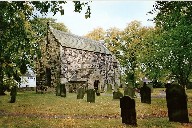 |
|
Last year I
discussed my visits to twelve great
cathedral churches. This year
I turn to the other end of the scale, and
would like to describe four tiny village
churches, one close to home, one just a
half-day excursion away, one on the Welsh
border and one in the far
north. I say village
churches, but only one today is remotely
close to human habitation, and we will
begin there, at Escomb, in County Durham.
Fifty years ago, according to John
Betjeman, Escomb Church was surrounded by
the refuse of industrialism.
The decay and squalor of a deserted pit
village have been replaced by mixed 1960s
council housing, but the village still
has a shop, a pub and a
school. At its centre stands
the incredibly moving St. John’s
Church, built in the seventh century, and
so witness to the Synod of Whitby, which
directed the English church towards Roman
usage rather than the Celtic Monastic
tradition. |
| Except for the
addition of a porch, it remains exactly
as it was then, tall and narrow,
incorporating stonework from the Roman
fort of Binchester. Though no
direct connection can be proved,
St. Wilfred, St. Hilda and the Venerable
Bede himself were all local
residents. Escomb also witnessed
first hand the Viking invasions, the
feudal reign of the Prince Bishops of
Durham, the building of the Stockton and
Darlington Railway and the northern
industrial revolution, all on its very
doorstep. Today, it is
beautifully cared for, with modern
lighting, oak seating and a new organ
– a tribute both to the local
community and its historical importance. Next in terms of age comes
Winterborne Tomson, in Dorset, a single
cell Norman Church with an
apse. With just Tomson Farm
for a neighbour, it is no longer in
regular use, as Tomson is but one of a
dozen Winterbornes. St. Andrew’s
has a perfectly preserved early
Georgian interior. The altar
is hardly visible, and although the
mediaeval screen has survived, the
all-important pulpit was built into it,
and parts of the loft make up the west
gallery. All the woodwork,
including a complete set of box pews, is
a beautiful silvery grey.
Winterborne Tomson is visible from
the busy A31, yet could be miles from
anywhere. It was almost
derelict at the beginning of the 20th
century, and was lovingly restored
by the Society for the Preservation of
Ancient Buildings, using money raised
from the sale of some of Thomas Hardy’s
manuscripts. Today it is in the
safe hands of the Churches Conservation
Trust.
|
|
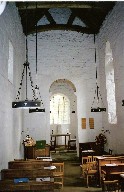 |
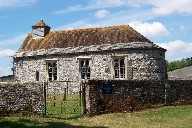 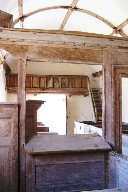 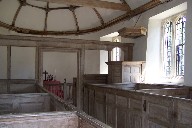
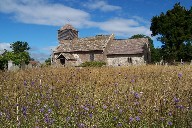 |
|
St. Margaret’s,
in Herefordshire really is miles from
anywhere, in the foothills of the Black
Mountains. Standing in the
churchyard, 800 feet up, there is no
sound except birds singing, sheep
bleating and an occasional dog barking in
the distance. The nave, chancel and
weather-boarded turret look nothing
special, but inside is one of the
greatest treasures any English church can
boast – a completely preserved early
16th century rood screen and loft, which
somehow, perhaps because of its very
remoteness, survived the order for the
destruction of such furnishings in 1547.
Its delicious carvings stretch
right across the church, resting on two
posts containing niches for statuettes,
now filled with daffodils in
springtime. The coving has
ribs with carved miniature bosses, and
here one can even stand on the loft where
the great rood once stood, supported by
figures of St. John and the Blessed
Virgin Mary. In high
summer the churchyard is a haven for wild
flowers, butterflies and other
insects. |
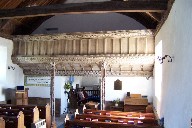 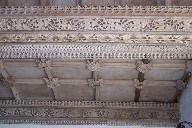 
And so we come
home to Up Marden. When I
first visited this church forty years ago
the churchyard was overgrown, with almost
impenetrable brambles covering enormous
anthills, with semi derelict barns all
round. Now the churchyard is
neat and tidy and the barns are smart
flint houses, for this is West Sussex,
not rural Herefordshire or impoverished
Durham.
Yet St. Michael’s remains
unchanged, the organic growth of
centuries of loving care within its
thirteenth century walls.
There is nothing special to note here,
but one must quote what Ian Nairn wrote
forty years ago: “At Up Marden
the atmosphere is as tangible as any
moulding, a visible testimony to the
faith of successive
generations. It is incredibly
moving whether one is Anglican or not,
whether one is Christian or not.”
One could say the same about all these
churches. They are all still
loved, however little they are used for
worship, and I’ll wager that
whenever you visit any of them you’ll
find the door open and flowers on the
altar, a living testimony of how well
they, and what they stand for, have stood
the test of time.
|
|
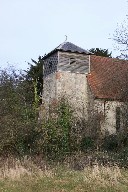 |
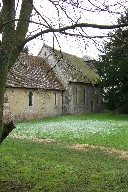 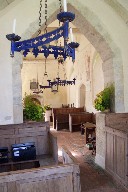 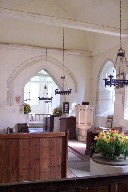
Tom
Muckley, February 2003
This article was originally published in The Rock, the magazine
of St. Peter’s, Petersfield, St. Mary
Magdalen, Sheet and St. Mary’s, Buriton.
tommuckley.co.uk
|
|

